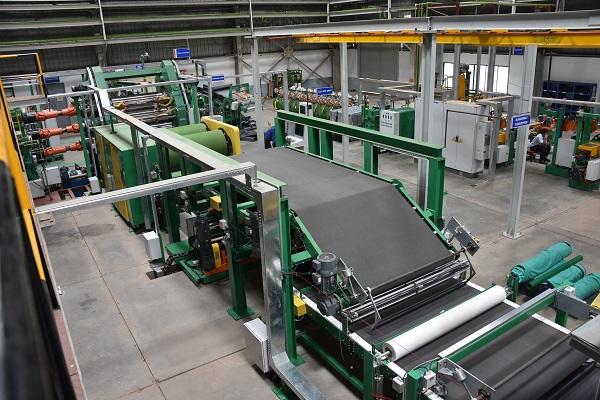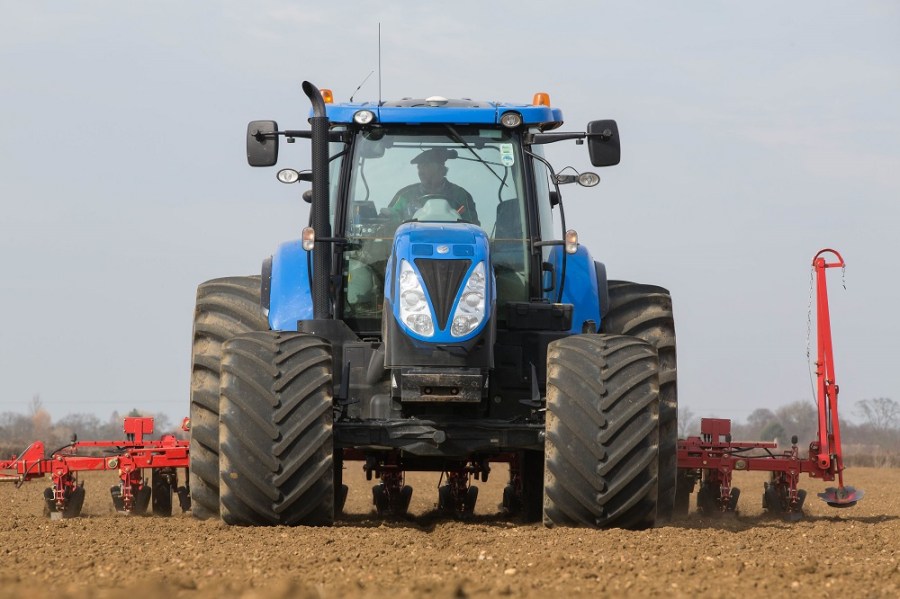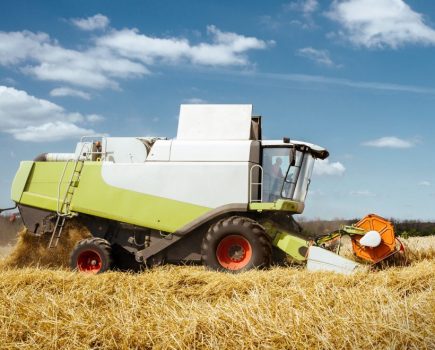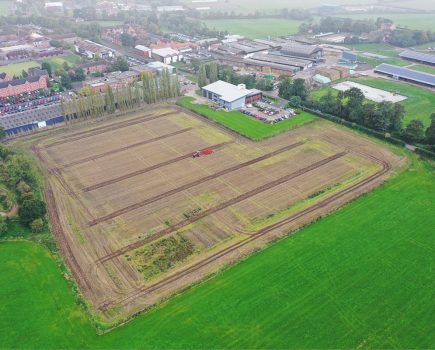Agricultural tyres represent a tool that should be adjusted and set according to ground conditions, topography, load weight and the task in hand. CPM seeks expert advice.
If applied pressure can be kept low then the growing action of most roots can actually cope.
By David Jones
It’s unlikely that any individual or organisation has done more to add to the sum of knowledge – and to provide advice – on how rubber meets soil than Philip Wright. The independent soil management specialist plans to use this month’s Tillage-Live event in Lincs as an opportunity to demonstrate the impact tyres can have.
“The plan is to illustrate the effect of a seedbed-making pass on and beneath the soil structure in the seedbed by the tyres on the tractor pulling the machine,” he explains. “We’ll have one running at ‘normal’ pressure – a typical setting for standard tyres at transport speed – and one at the lowest possible pressure, assuming either VF-type (Very high Flexion) tyres are used, or where the pressure is let down to a safe minimum for field work on a more conventional tyre.”
Philip’s expecting to find the soil structure will differ significantly between the two zones, which would materially affect germination and crop growth, he says. Where the soil is most vulnerable – when wet and/or loose – lower tyre pressures will achieve a significantly better result for the crop, he says, in terms of consistency, competitiveness and overall higher yields.

“Ideally, in many situations, if applied pressure can be kept low – less than 0.7 bar – then the growing action of most roots can actually cope and enable the plants to sort out the problem without the need for mechanical effort,” he states.
Philip accepts that if Controlled Traffic Farming (CTF) has been adopted and involves relatively wide kit, such issues are reduced. However, with many farmers using, for example, 3m or 4m power harrow combination drills, or narrower kit running at angles, the problems can add up.
“For a 4m combi behind a tractor with 710-wide tyres, the affected area is around 1.5m (710 at the ground contact patch is up to 0.75m per tyre). Across the field, this equates to just under two fifths of the farmed area. If we add this to the turning headland zones compacted to a wider area, this takes the total easily to 40%.” What’s more, the action of the tyres on the soil in itself can stimulate blackgrass growth, which further exacerbates the situation. Higher levels of wheel slip into a loose profile – when higher pressures are used – are the culprit here,” adds Philip.
But choosing the right tyre can make a sizeable difference, says Steve Lamb, of manufacturer Bridgestone. He believes few farmers and contractors may be fully aware of the range and sophistication currently on the market, and underlines the fact that IF (Increased Flexion), VF and CHO (Cyclic Harvesting Operation) specifications have been available for some time now.
“Many agricultural businesses don’t fully appreciate the huge benefits these specifications would bring to their operations today,” he states. “Take VF technology as an example: it offers a 40% benefit – yes, 40% – over that of a standard tyre of the same size. This means that by changing onto VF tyres you can either increase your carrying capacity or reduce your operating pressure by 40%. So that’s 40% less soil compaction, simply by changing your tyre spec.”
At the same time, he continues, users could, in some cases, reduce their field or transport width by switching from 900s to 710s. This would reduce the width of compaction by 380mm per axle – or going from 800s to 650s would narrow it by 300mm – simply by exploiting what the latest VF technology has to offer users.
Those running dual wheels could eliminate the need for them altogether – unless needed for reasons of stability – by changing, Steve suggests, as an example, from four 650/65 R38 @ 0.7bar, to just two Bridgestone VF650/65 R38 @ 0.9 bar, “which is probably a better answer to the challenge of reducing costs, time and overall soil compaction.”
When comparing tyre options, farmers should be looking at which offers the lowest ground pressure – and at what working width – in order to reduce soil compaction, he advises. So, providing the tyre is appropriate for the application, the lower the working pressure and the narrower the tyre, the better for the health of the field.
Steve believes that the relentless drive for greater productivity and efficiency will continue to fuel the quest for ever increasing tractor horsepower, working loads and speeds. “This is the constant challenge that tyre manufacturers face,” he says. “We’re producing a product that has the lowest pressure and tyre width, yet can cope comfortably with the higher horsepower, heavier loads and greater speeds. The type and construction methods are evolving, with, for example, pneumatic, departmental and non-pneumatic tyres.”
The tyres of the future, he predicts, will also have the ability to relay live data – on pressures, temperatures, wear and health and condition – using in-built telematics. This will be displayed in the cab, on mobile phones and at the base office. “That’ll assist greatly in pre-empting potential problems – in field and on the road – via message alerts.”
On-board inflation systems will play a significant role in achieving greater productivity, giving operators the ability to instantly regulate the machine’s tyre pressures on the move, he continues. “Fully integrated Central Tyre Inflation Systems (CTIS) are already available, such as Fendt’s VarioGrip, and this feature will become more widespread among tractor manufacturers.”
The ability to increase or decrease pressures automatically, on the move may be one step forward, Steve believes, but the next logical development would be to establish the link with GPS and field-mapping systems, providing the farmer with a fully integrated inflation system embracing tractor, trailer and implement.
This would provide the ability to take account of actual soil types and conditions in a field upon which the tyres are travelling, together with the specific task – ploughing, drilling spraying, etc – and ensure the optimum tyre pressures were applied accordingly.
For Kirk Walker, technical manager at Mitas Tyres UK, the single most important action farmers can take to minimise soil compaction is to us the correct pressure for the job.
“To do that,” he maintains, “requires an understanding of the relationship between inflation pressure and ground pressure. Inflation pressure is linearly related to ground pressure, so the harder your tyres, the more damage you’ll inflict on your soils through compaction.”
It’s important to remember, he stresses, that such compaction isn’t restricted to the upper layers of the soil. Studies have shown clearly that compaction can reach down to as deep as 2m, so the damage can be both significant and long-lasting.
“Most fieldwork and cultivations depend on achieving a balance between pressure and slippage – the lower the inflation pressure, the greater the footprint and the more the weight of the tractor and cultivation equipment will be spread across the ground,” says Kirk. “However, if you take it too far, you’ll lose traction and risk damaging the sidewalls of the tyre through excessive flexing.”
For standard radial tyres on a mid-horsepower tractor on the field without equipment, he believes around 1-1.25bar on the front and 1.2-1.4bar on the rear is a good starting point, with fine-tuning to follow as befits the conditions and the job in hand.
“A good working slippage rate would be in the area between 15-25%,” he states. “Above this and you’re going to be smearing soils, especially in wetter conditions. But if conditions are good, you can adjust tyre pressures to suit the job being done and obtain the optimum performance from your tyres.”
However, Kirk believes that a far more accurate method of assessing the most appropriate pressure for the job involves measuring the axle weights with equipment hitched to the tractor – ideally with the heaviest equipment and front weights being used.
“With modern four-wheel drive tractors,” he continues, “60% of the weight should be over the rear axle and 40% over the front. In order to achieve this, you’ll need to measure the weight carried by each wheel, then use the manufacturer’s recommendations to work back to the lowest safe working pressure. Then, adjust these to the speed of travel and the weight being carried.”
Kirk expresses the view that it’s the reluctance of operators to adjust tyre pressures between road and field use which is one of the main reasons why compaction has become such an issue.
“Work out what pressure you need for the road to get to the field,” he advises, “and then what the optimum value is once you get into the field. The problem is that most operators don’t have access to a compressor to re-inflate tyres for the journey back. This is something that farmers might need to address, but looking at the potentially significant crop production losses – even from medium compaction – a central inflation system is certainly worth considering, or, at the very least, a tractor-mounted compressor.”
Kirk concedes that this option won’t always be practical, but that users might want to consider running on VF tyres. He suggests the Mitas HC1000, HC2000 and HC3000, adding that these ranges cover all the popular standard, row crop and harvester sizes.
“They allow you to use optimum inflation pressure for field work but are also safe on the road, as their sidewalls are designed to deform much more than conventional tyres, without causing damage to the carcase.”
This means that operating pressures can be reduced significantly, providing a much larger footprint in the field, so minimising damage to the soil and improving traction – but without the need to re-inflate for road work.
“Finally,” Kirk concludes, “do recognise when it’s time to change your tyres. If lugs are worn or rounded you won’t be getting the same grip, which means, automatically, higher incidence of slippage, soil damage and lower outputs.”
BKT introduces the ‘Smart Tyre’
The Indian manufacturer’s principal new tractor tyre product this year is the Agrimax V-Flecto which, it says, has resulted from a combination of technologies.
The claims appear impressive – the Agrimax V-Flecto delivers reduced soil compaction, lower operating costs, higher load capacity, no requirement for alternative rims – nor to have to adjust tyre pressures between field work and road transport.
The Agrimax V-Flecto is the first tyre from BKT to employ NRO (Narrow Rim Option) technology. This designation allows the use of recommended standard-size rims, as opposed to specific rims that are needed for VF tyres of the same size. In addition, it’s stated that the working life of the new tyre is 10% longer than for a standard equivalent, making it more cost effective, in terms of delaying the need for replacement and lower maintenance.
The flexibility to run the Agrimax V-Flecto equally well in field and on road is attributed to ultra-resistant casing and special reinforced beading.
One of the new tyre’s appeals to users, BKT believes, will be the ability to maximise the load without having to alter the inflation pressure, regardless of speed of travel. It claims that fitting the new tyres will enable 40% more weight to be transported, when compared with a standard tyre of the same size and with the same recommended rim.
In the field, a reduction in soil compaction is achieved as a result of a streamlined footprint and a 10% larger tread profile.
BKT says users will also benefit from enhanced driver comfort, thanks to a new optimised lug angle design that reduces both vibration and noise during transport phases.
At Agritechnica the company plans to debut the FL 637 – a tyre specifically designed for spreaders, trailers and tank trucks. This features directional tread design, while the steel-belted structure ensures increased durability along with higher load capacity, says BKT. These are combined with good flotation properties and low rolling resistance, available in size 520/50 R17.
A new name in tyres
CEAT Speciality Tyres, based in Rotterdam, is a European subsidiary of USD, one of India’s largest conglomerates. With the aim of building its business in the UK, CEAT will be promoting a comprehensive range of tyres designed and specified for tractors, combines, implements and slurry tankers.
A clear customer focus is what farmers will see from the company, reckons managing director Kumal Mundra. “We’re very confident in our product quality and therefore happy to offer a very consumer-friendly product warranty and quick-response technical service support.”




